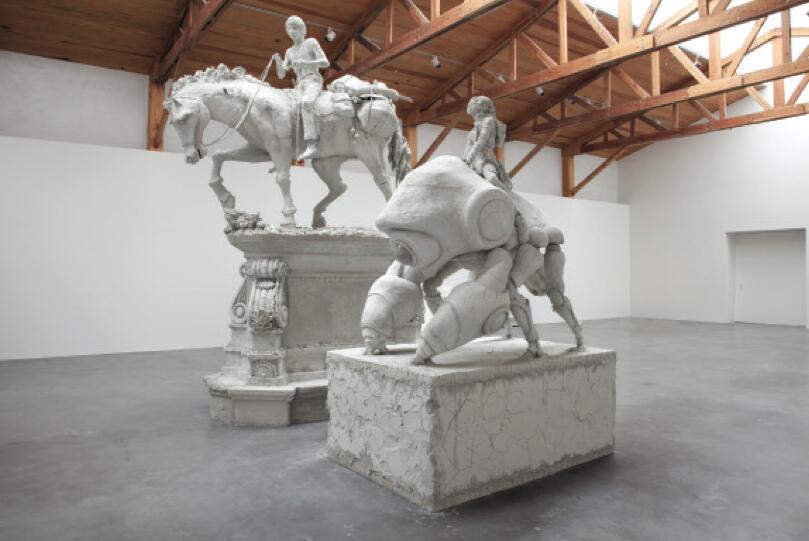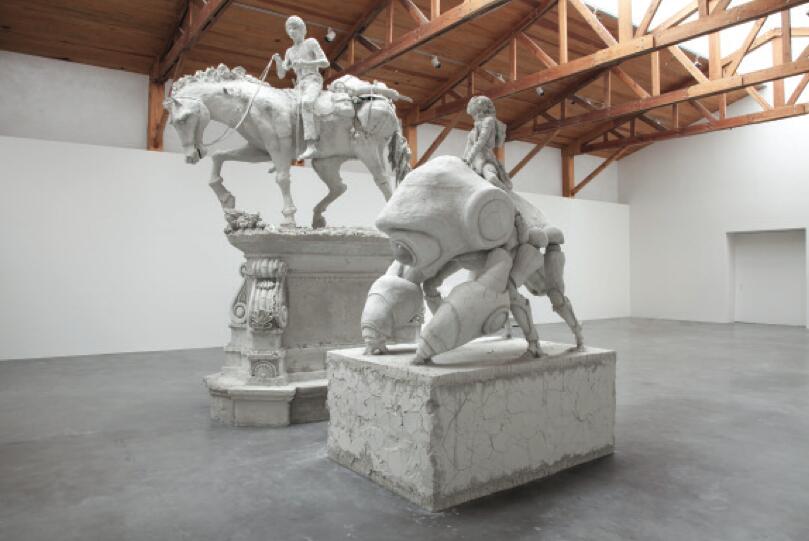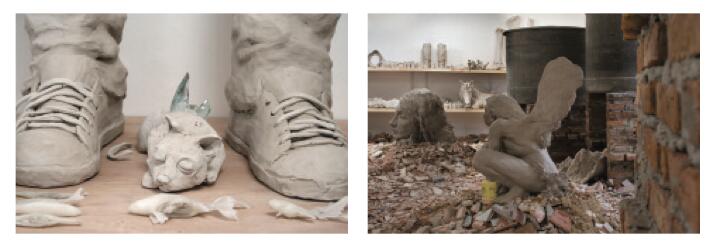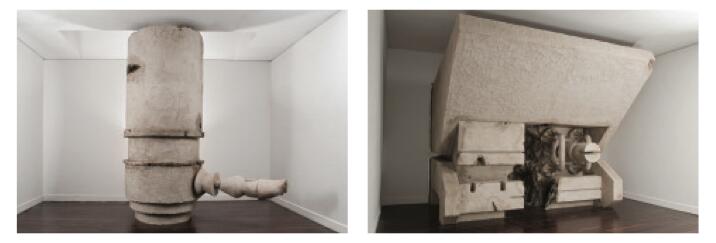Adrián Villar Rojas
I am not ready to lose anything Future memories
At the age of 30 and backed by a trajectory that is short in terms of time but extremely fruitful, even in the international arena, Adrián Villar Rojas is officially representing Argentina at the 54th edition of the Venice Biennial. At 23, Villar Rojas was awarded first prize at the “Currículum 0” competition for young artists, organized annually by Ruth Benzacar Gallery, a distinction that entails the presentation of a solo show the following year. Thus, in 2004 he made his appearance in the Buenos Aires art scene with the exhibition “Incendio” (Fire), which comprised 98 small format works (drawings, collages) and two six-meter paintings of dinosaurs, which prefigured much of what the artist would produce in the future.

Some people took note of the flight of his imagination, of his choice of working simultaneously in monumental dimensions, featuring large figures of reptiles, perhaps resembling the mythical dinosaurs, and in small formats, with drawings related, once again, to comic strips. At that time, it was already possible to perceive his artistic potential and a serious commitment to his work. During the next few years, his itinerary was marked by his participation in numerous group exhibitions and art fairs, and in four solo shows in venues with dissimilar degrees of visibility. But he undoubtedly attracted attention in 2007, when he was selected to participate in the “ArteBA- Petrobras Award” − in the framework of the 16th edition of ArteBA, the Contemporary Art Fair held annually in Buenos Aires − featuring a remarkable installation, Pedazos de las personas que amamos (Pieces of the persons we love), in which he constructed dozens of instants and objects that were part of a life about to end voluntarily and intentionally, exhibited on a huge, table-high wooden board.
At a later stage, in 2008, he settled in Buenos Aires − leaving Rosario, his native city − to work for his next exhibition to be held in November of the same year at Ruth Benzacar Gallery. After the deep and lasting impression caused by the extraordinary installation Lo que el fuego me trajo (What fire brought to me) − an excessive and silent environment brimming with memories of the future − critics and collectors focused increasing attention on him, and the artist began to receive invitations to participate in international events.
A disturbing sight, Lo que el fuego me trajo faced the viewers with the destruction and the generation of universes that were as intimate as they were colossal, intertwined in a mysterious arm wrestling. “I make monuments because I am not ready to lose anything”, was, to the surprise of many, the statement of this young artist, who appeared to be stubbornly trying to store forever a combination of affections and presences that had provided him real or imaginary shelter at some point. “It is as though I had died 200 years ago.” In the manner of an archaeological finding, still to be arranged and in varying states of conservation, on a floor covered with debris and some wooden shelves, Villar Rojas gathered together several architectonic elements, winged human figures, animals, fossils of gigantic beasts, fantastic beings, car parts, everyday utensils, articles of clothing, organic forms, indiscernible objects made from clay by the artist and some assistants.
Some days after having viewed this charming exhibition, the author of these lines invited Villar Rojas to participate in the 10th Cuenca Biennial held in Cuenca, Ecuador, which took place in October 2009. The project addressed “the poetics of water” through the execution of a 6.5 by 6 by 21 meter site-specific sculpture made of local reddish clay (unbaked), gesso, sackcloth, wood, rocks, and glass. In El momento más hermoso de la guerra no sabe distinguir el amor de cualquier sentimiento (The most beautiful moment of the war does not know how to distinguish love from any feeling), the figures of a young man and a huge, unknown animal, intertwined and at rest, emerged like an apparition in a low-lying area 150 meters away from a river.
In 2009, Villar Rojas also participated in the 2nd San Juan Poly/Graphic Triennial (Puerto Rico), and in the 2nd Biennial of the End of the World, Ushuaia (Argentina), where he presented Mi familia muerta (My Dead family)(5 x 3.5 x 28 m.): a gigantic whale stranded in a forest, an image that circulates as a photograph and is already an icon of Argentine art. That same year he created works for “Panorama das Artes Brasileira”, staged at the Museum of Modern Art in Sao Paulo (Brazil), and the impressive sculpture Moby Dick for the Wattis Institute for Contemporary Arts in San Francisco (U.S.A.). Unstoppable also in 2010, he was invited to participate in the “Map Marathon” featured by the Serpentine Gallery in London (England); in the “Panamericana” Group show at Kurimanzutto Gallery, Mexico, where he presented the sculpture Las mariposas eternas (The eternal butterflies), two large pieces in the manner of antagonistic equestrian monuments, and in the “Zona MACO Project Room”, featuring books as sculptural objects, also in Mexico City. He also took part in “The return of the landscape”, Berlin Academy of Art (Germany) with Mi abuelo muerto (My dead grandfather), another site-specific work measuring 5 by 23 by 4 meters. He was the recipient of several scholarships, and in 2010 he participated in artists’ residencies in Canada and Colombia, where he presented “Un beso infinito” (An infinite kiss) − a solo show at Casas Riegner Gallery, Bogotá − an installation made from wooden pieces covered with clay; in its unusual dimensions, the protuberance emerging from the gallery wall and split by a huge crack appeared almost abstract, perhaps part of an excavation; another segment was perhaps part of some mechanism (a pipe or something similar) that generally remains out of sight. In 2011, the artist’s engagements continue in France, Brazil, and of course, Venice, where Argentina will have at its disposal 250 square meters in the Arsenale Pavilion. Villar Rojas will surely amaze visitors once again, and he will certainly make a wise use of the space; it is no minor detail: he relies on a well-oiled production team.
The project for Venice has not yet been defined, but Villar Rojas’s work generally addresses future memories. With a touch of melancholy, from this present he imagines the end: he speculates on the extinction of the human race, the end of art and the end of time. But in his fascination with mixtures, from the inclusion of Michelangelo’s David (reproduced at a smaller scale in Lo que el fuego me trajo) to the title of a song by the rock band The Rapture (Pedazos de las personas que amamos), coincidences and extremes, the artist generally alludes to love as much as he does to loss. In like manner, he invariably fuses epochs, aesthetic searches, artistic practices (video, photography, painting, and drawing). His penchant towards interactions have led him to participate in a series of interventions of urban transport travel cards, to include comic strip (of which he is an avid reader) and Internet imagery, to explore the artistic direction of several records and to work as a DJ.
An ambitious person, Villar Rojas will not settle for just anything. When the funds for the monumental sculpture he wanted to execute in Cuenca could not be obtained, the signatory of these lines suggested that he present a small work. Convinced of his purpose, the artist preferred to pay a large part of his share of expenses and the cost of two helpers (his assistant did not travel) and go to a lot of trouble rather than changing the project, which included weeks of outdoor work in the Andes and a complex engineering that demanded more passion and talent than clay and water. The resulting sculptural ensemble endowed with an enchanted atmosphere is a scene-in-progress rather than a commemorative monument. The spectator wishes to imagine that the saga of the young man with a slovenly appearance tightly hugging his mythological pet will continue; so will Villar Rojas’s.
Perfil:
Adrián Villar Rojas was born in 1980 in Rosario, Santa Fe (Argentina) and he completed his BA (FA) studies at the National University of Rosario. He had his first solo show in his native city in 2003, at the Juan B. Castagnino Municipal Fine Arts Museum. An assistant to Jorge Macchi for some years, he considers that job a learning experience. He curated several shows, among them “Tiempo Perdido” and “macro + canciones” (both at the Museum of Contemporary Art in Rosario –MACRO). In 2010 he was awarded the Raul Urtasun - Frances Harley Scholarship for Young Emerging Artists from Argentina, which allowed him to attend a Visual Arts residency at the Banff Centre, Alberta (Canada). He was also the recipient of the Nuevo Banco de Santa Fe Incentive Scholarship for Young Artists (2006), he was the winner of an award at the Bahía Blanca National Contemporary Art Biennial – 2005, and was preselected to participate in the “Rolex Mentor Scholarship Program” (2005). In 2011, the artist will show at Luisa Strina Gallery, Sao Paulo (Brazil), he will take part in a residency program at SAM ART Projects - Villa Raffet à Paris (France), and he will participate in the Istambul Biennial. Hans Ulrich Obrist, Co-Director of Exhibitions and Programmes and Director of International Projects at the Serpentine Gallery, London, distinguished him as one of the “young artists from Latin America that had dazzled him”; his work was included in the latest Cream series by Phaidon Editors.


![My dead grandfather [Reprise Edition], 2010. Site specific sculpture. Clay (unbaked), cement, burlap fabric and wood, 16.4 x 75.5 x 13 ft. Akademie der Künste - Berlin - Germany. Photo© Adrián Villar Rojas. Mi abuelo muerto [Reprise Edition], 2010. Escultura site specific. Arcilla (cruda), cemento, tela de arpillera y madera, 5 x 23 x 4 m. Akademie der Künste - Berlín - Alemania. Foto © Adrián Villar Rojas. My dead grandfather [Reprise Edition], 2010. Site specific sculpture. Clay (unbaked), cement, burlap fabric and wood, 16.4 x 75.5 x 13 ft. Akademie der Künste - Berlin - Germany. Photo© Adrián Villar Rojas. Mi abuelo muerto [Reprise Edition], 2010. Escultura site specific. Arcilla (cruda), cemento, tela de arpillera y madera, 5 x 23 x 4 m. Akademie der Künste - Berlín - Alemania. Foto © Adrián Villar Rojas.](/var/artealdia_com/storage/images/international/contenidos/artistas/adria_n_villar_rojas/adrian_2/456746-1-esl-AR/Adrian_2_full.jpg)





